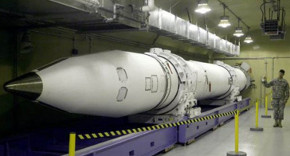In a move that is being described by officials as “historic,” and has the manufacturers of the systems drooling about making and selling more of them the US managed to “successfully” intercept an “ICBM” today at the Ronald Reagan Missile Defense Test Site, in Kwajaleiin Atoll.
 This is meant to be interpreted by the public, and particularly the check-writers in Congress, as proof the US missile defense system “works” and could shoot down ICBMs fired by North Korea at the US mainland, across the Pacific Ocean, foiling a potential attack.
This is meant to be interpreted by the public, and particularly the check-writers in Congress, as proof the US missile defense system “works” and could shoot down ICBMs fired by North Korea at the US mainland, across the Pacific Ocean, foiling a potential attack.
What it actually means is a lot less certain, and far less impressive. The missile defense system actually only managed to shoot down a slower moving, “threat-representative” ICBM-styled target, and then with exact specifications from the side that fired the object about the target’s size, time of firing, and precise trajectory.
That means knowing every bit of information about the target, the US missile defense system managed to physically hit the object under 100% optimal conditions, which should be little assurance of its functionality, particularly since previous tests under similarly optimal conditions have succeeded only about half the time.
An actual ICBM would not only be faster, but the US wouldn’t know its exact specifications, exact trajectory, or the specific instant it was fired. Perhaps the biggest problem is they wouldn’t have this data weeks in advance to pre-position the missile defense exactly where it would have the best shot of doing something.
The physics behind getting two missiles to intentionally collide in the air is complex, and that they were able to do it this time at all is impressive, but in a real life situation, rapidly verges on the impossible, with a non-trivial chance that a fired ICBM would not have an intercept trajectory that the missile defense systems could match even n theory.
Still, that hasn’t stopped the US investing a preposterous amount of money into 36 ground-based interceptor missiles, mostly deployed n Alaska, which almost certainly would never work in a combat situation, and which on the basis of occasional “success” in tests that should be wildly easier than a real situation, are going to continue to be invested heavily in.
If there is consolation to be had, it’s that North Korea’s missile program is actually far from being able to deliver anything to the continental US. The missiles stacked in Alaska, waiting to fail at their one designed purpose, simply aren’t going to be needed, which s a big part of why everyone is comfortable with dumping more money into them. People are only going to complain about a defense system that doesn’t work if it fails, and these look just as shiny sitting in a warehouse as anything else, which is all they’ll likely ever have to do.


